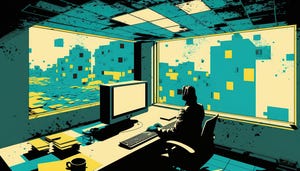Upcoming exhibition to feature China's emerging indies
What's China's indie game scene like? Bryan Ma is curating an exhibition of Chinese art games for Babycastles in New York City, and talks to Gamasutra about some unique challenges facing the nascent space.

New York-based Babycastles has long made it its mission to bring unique and unusual independent games arcades to gallery shows, DIY spaces and educational venues, in collaboration with makers who build arcade cabinets and artists who paint them. Now, it's partnering with contemporary art festival The Armory and the Ace Hotel to present Art Games in China, a one-month pop-up arcade curated by Bryan Ma beginning March 6. Art Video Games in China is described as "an investigation into works by Chinese game designers that attempt to break the norms and subvert the mainstream narratives of the Chinese video game industry through works focused on personal expression and values." The Ace Hotel will host the exhibition, where works chosen by Ma will be displayed in arcade cabinets painted by local New York artists. Bryan Ma has spent most of his games industry career in Shanghai, working as a producer and a designer for 2K Games' branch there. Later, he says he became more involved with independent games through speaking, writing and events. He became friends with Coconut Island's Wesley Bao and other local indies attempting to build a scene in China. "As I was beginning to interact more with the scenes in other developing countries, I was always struck by the uniqueness of the situation in China, as I was lucky enough to get a fairly intimate view of it," Ma explains. He says China's indies face a unique set of problems: a local market that hasn't taken off for independent creators the same way it has in the West. "Digital distribution is the norm, but the majority of published products that reach eyeballs and make money go through some very iron-fisted, practically monopolistic channels," Ma explains. "Revenue comes from monetization models that those channels enforce, and for good reason, commercially speaking," he continues. "People aren't used to spending money on games as a non-online product, outside of the Chinese iOS and Android app stores and in cracked or pirated copies of games that you can buy from DVD shops." The Chinese indie scene, or as Westerners understand "indie scene," is in relative nascence. "It's very much characterized by a lack of a 'substantive' identity, from a broader perspective," says Ma. As a consequence, independent creators are often left behind design-wise, or end up producing derivative works as they aim for some subset of local market tastes or try to stay afloat in the App Store's international market.
"Mostly, [Chinese] indies are small companies trying to survive, or hobbyists making things that sometimes reflect a lot of insularity and lack of exposure."
"The pursuit of individual expression in an industry, market, and cultural context highly opposed to it might be a way to look at it," he suggests. "But mostly, [Chinese] indies are small companies trying to survive, or hobbyists making things that sometimes reflect a lot of insularity and lack of exposure. Things are moving slowly. There is no Indie Game The Movie or similar popular narrative in China's games community, as I understand it." There's an Independent Games Festival presented through GDC China, and Ma says it helps expose locals to work developed by foreign creators based in China or from elsewhere in the Asia-Pacific region. Babycastles' Ben Johnson was acquainted with Ma, and helped invite him to curate the show at The Armory. "We knew it was going to be pretty tricky from the start," says Ma, "but I was mostly interested in looking for non-commercial independent work done by just a few people or less -- games that were being made by people who were interested in using them as a platform or delivery form for personal expression primarily, and who were not trying to make something explicitly commercial." The developers on show are Buran Deng, Huang Tianxiao, Yi Wang, Zhipeng Li, Danqing Wang and Peng Bitao -- the latter is the creator of inpla.net, which Ma says can be thought of as China's TIGsource. Ma says the exhibited works range "from minimalistic to nostalgic, non-gamey to more conventionally so." "It's a small collection of playable material plus some media from other works, not currently playable, but I'm happy that it covers something of a spectrum," he says. "I always admired Babycastles' work in NYC greatly and am super happy to be collaborating on this with them, especially as talking about independent game development at a global scale is entering more and more of the public discourse. Having spent eight years so far outside of the U.S. has really influenced me in that respect and I'm really happy to be able to share this." Babycastles co-founder Syed Salahuddin says the collective has been working on honing its mission, "a manifesto of sorts inspired by Anna Anthropy's book 'Rise of the Videogame Zinesters' where we have decided to be an all-inclusive organization (open to all ages and identities) exhibiting and celebrating independent experimental video games." "Since our humble beginnings our exhibitions have been moving away from presenting games in traditional arcade cabinets to filling up entire spaces inside galleries and museums with sculptural and highly immersive experiences," Salahuddin explains. "We've built a cat town in Paris, a spaceship at the Museum of Natural History's planetarium, and a Keita Takahashi-designed '3D Pac-Man' room at the Museum of Arts and Design... We're in the process of planning an independent Islamic games exhibition for our new gallery titled: 'Assalamualaikum Babycastles'." Soon, Babycastles will have its own home, Salahuddin hopes: "We've been incredibly excited about starting a new venue in NYC, a three-to-five-year project tentatively called the 'Babycastles Gallery,'" he says. "It is a space for exhibiting and supporting artists that create sculptural and experimental work that doesn't necessarily fill the traditional molds of a video game. We're focusing on game designers that have outgrown the independent games arcade scene and are looking for a space to go wild in."
Read more about:
2014About the Author(s)
You May Also Like













